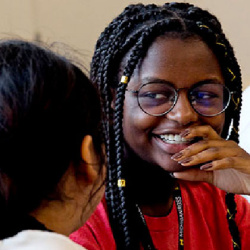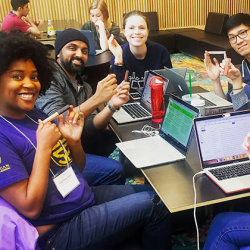Explore the faculty research, thought leadership, and groundbreaking philosophies that established Michigan Ross as one of the world’s top business schools.

Four student-run venture funds are currently operating at Michigan Ross, more than any other business school. Collectively, these funds manage a portfolio worth more than $10 million. These funds help students learn about investing early-stage capital by making real deals with real companies and real money. The concept of student-run venture funds has been adopted by universities around the world.

In 2008, an article by Michigan Ross Professor Scott Rick changed how academics, practitioners, and the general public thought about consumers’ spending habits. The key insight was that many people who spend very little are frustrated with their behavior. They consistently spend less than they think they should, often with negative consequences for themselves and those around them. Under-spenders (“tightwads”) and over-spenders (“spendthrifts”) are two sides of the same coin: both experience conflict and distress around their spending habits. The scale Rick and colleagues developed to measure these tendencies has become widely used by marketing and psychology researchers. The tightwad-spendthrift construct attracted even more attention when Rick and colleagues demonstrated that tightwads and spendthrifts are more likely to marry one another than they are to marry someone like themselves. This “opposites attract” pattern is initially enjoyable, but eventually, as partners begin to confront a never-ending series of joint spending and saving decisions, tightwad-spendthrift differences harm relationship quality.
This research has attracted broad attention beyond the boundaries of marketing academia. It has been the topic of webinars, podcasts, and other features produced by the National Science Foundation, the American Psychological Association, the National Academy of Sciences, and the World Economic Forum. It has received years of sustained coverage from media outlets such as NPR, the New York Times, and the Wall Street Journal. Financial organizations like the CFP Board, ING, Charles Schwab, and Equifax have informed their clients and customers about the implications of this research. Most notably, in 2024, St. Martin’s Press published a mass-market book about this research, titled Tightwads and Spendthrifts: Navigating the Money Minefield in Real Relationships.

Associate Professor Anant Nyshadham co-founded and co-directs the Good Business Lab, a labor research and innovation lab whose work to identify workplace tools and interventions to deliver both impact to workers and returns to employers has quickly expanded across four continents over the last decade. Designed and tested through rigorous randomized controlled trials in real-world workplaces, GBL has developed several tools for rapid and broad scale. GBL's worker voice tool, Inache, has been proven to improve worker retention, reduce absenteeism, and increase worker productivity in manufacturing settings. Similarly, the tool Pratibha is a tablet-based screening and training tool for frontline supervisors that measures and addresses soft skill deficiencies and has been proven to improve the retention of supervisors and dramatically and sustainably raise the productivity of workers in factories. The Bill and Melinda Gates Foundation recently awarded GBL a multi-million dollar grant to scale these tools to more than a million workers in the next two years.

Professor Charles Laselle Jamison, a pioneering figure in the sphere of business management, spent most of his career at the Michigan Business School. Recognizing the importance of the evolving field of management education in 1936, Jamison proposed an organization dedicated to the support of high-quality research, teaching, and practice in the field. His vision led to the official launch of the Academy of Management in 1941. For this instrumental role, he became known as the "Father of the Academy of Management." With the onset of World War II, the Academy's operations were put on hold. However, they were revived in 1947 thanks to Jamison's tireless commitment. Since then, the Academy of Management has become an internationally recognized association for management and organization scholars.
Later in his career, Jamison would cement his legacy as a pioneer in the field of strategic management by publishing his 1953 textbook on business policy. The textbook was one of the first on the subject and showcased his invaluable contribution to the field.

In the early 2000s, Professors Tim Fort and Cindy Schipani held the first conference on the role of business in promoting peace. The conference was attended by former Secretary of State Madeline Albright and brought together individuals from academia, business, and government to discuss efforts that could be made to reduce violence in the world. It was concluded that there is a role of business, especially in serving as an unofficial ambassador or role model when conducting business internationally. This event set in motion the beginnings of a new research paradigm on "Peace Through Commerce."

The Personal Development Plan is a simple but impactful idea that has now been utilized by approximately 6,000 BBA alums and current students. At its core, the PDP is an Excel document that helps students plan the requirements to graduate, but its usage and value go far beyond just a requirement planning tool. In 2006, the BBA degree, which had for decades been a two-year degree program, was modified to a three-year structure with a small number of first-year preferred admits. Eight years later, in 2014, the BBA curriculum was modified from a 45 business credit requirement to 58 business credits. The changes to the curriculum meant that students had significantly more time, more flexibility, and more choices in how they progressed through the BBA degree. That flexibility increased even more as we moved to a four-year program in 2017. Advisors developed the PDP as a resource to help students make the most out of this expanded college experience.
In 2014, with the launch of the 58-credit BBA curriculum, a new core course was created, BA 200. As part of BA 200, PDP was introduced as a required component of the class and is now a co-curricular component of BA 100 and BA 102. Each year, the undergraduate advising team works with over 625 new BBA students (first-year students and transfers) so that each student develops an individualized plan for their life as a college student. Ensuring that they are planning requirements is an important part of this, but in developing their plan, students are asked to reflect on their goals for their time in college while developing their PDP. What skills and competencies do they hope to develop while they are here? Are there opportunities they want to take advantage of (study abroad, participation in programs through centers and institutes, minors or dual degrees, club leadership, etc.)? The PDP is a living document that travels with students throughout their four years and becomes a reference point for continued conversations and relationship-building with advisors until graduation. The PDP has had an impact on every single BBA student since the fall of 2014, helping to open their eyes to the rich opportunities at Michigan Ross and giving them a roadmap to their unique journey as a Ross BBA.

In 2006, Professor Sue Ashford, associate dean for leadership programming, founded the Ross Leadership Initiative, which was the precursor to the Sanger Leadership Center and one of the first organized leadership programs among business schools worldwide. The initiative was influenced by Ashford's research on learning leadership via experience and Professor Noel Tichy's action-based learning concepts. Suddenly students were not just learning about leadership but were actually engaged in doing it. Prominent among these efforts was the highly influential Leadership Crisis Challenge, which puts students in the hot seat needing to resolve a crisis in the moment. This program was recognized with the Provost's Teaching Innovation Prize in 2011 and remains a prominent and popular program in the school to this day. Later, under the leadership of Professors Scott DeRue and Gretchen Spreitzer, RLI grew and launched new programs that persist today, including Story Lab, the Ross Leaders Academy, and more. In 2015, alum Stephen W. Sanger, MBA '70, and Karen Sanger made a defining gift of $20 million to establish the Sanger Leadership Center. With the Sangers' gift, the Sanger Leadership Center, now under the leadership of Professor Lindy Greer, has created an array of custom programs and workshops and now offers leadership development programs for students across the university.

Michigan Ross has long been a pioneer in entrepreneurial education, introducing the nation's first course on entrepreneurship in 1927. However, in the early 1970s, Professor LaRue Hosmer played a pivotal role in championing entrepreneurship education at Ross. He developed and taught courses in small business management and a seminar on small business formation. He is considered the founder of the Michigan Entrepreneur Track and has also inspired present-day entrepreneurship faculty at Michigan Ross, including Professor Andy Lawlor. Lawlor was a student in Hosmer's entrepreneurial management course in 1973, and Hosmer has been an important mentor to Lawlor, helping to bridge the gap between business and teaching. Lawlor began guest lecturing under Hosmer's guidance in 1975 and assumed the teaching responsibilities for the entrepreneurship classes in 1981. Over the years, many successful companies have been born from Hosmer and Lawlor's teaching.

The public corporation in America is vanishing, and more people, from low-income earners to professionals, are doing their work in the so-called “gig economy.” The work of Professors Jerry Davis and Sue Ashford put these two issues on the research agenda of scholarly colleagues. Davis documents the first idea in his book, The Vanishing American Corporation (2016). Although some scholars have suggested that over-regulation might account for this surprising trend, he argues that a more fundamental shift in the economy, enabled by information and communication technologies, was ultimately responsible. By making it cheaper to "buy" rather than "make" inputs (from capital and labor to supplies, manufacturing, and distribution), information and communication technologies have made the parts of an enterprise like a pile of Legos, ready to assemble into a business, scale, and disassemble. This idea explains Nikefication, Uberization, Amazon, and other recent trends in the organization of the U.S. economy, as well as why the same technologies are used differently in different countries, resulting in very different corporate structures. If what Davis says is true, then fewer people will be working in large public corporation settings going forward. This shift may account for the growth in people working independently, some using technologically mediated apps to find and conduct work. Ashford puts the gig economy and gig workers on the agenda of people wanting to understand individuals at work. Her qualitative and quantitative studies identify the challenges faced by those working independently and what they can do to survive and thrive. Challenges include maintaining one’s identity, keeping sufficient income flowing in, staying organized, finding and maintaining work connections, and figuring out how to make working in this manner work over the long run. This research tests a variety of interventions and solicits ideas from individuals working in this manner regarding strategies that make this kind of work-life viable and enlivening.

In 1991, Professor Priscilla Rodgers designed an assessment to help the Michigan Business School evaluate MBA students' written communication skills, which was used for course placement. When the GMAT added an Analytical Writing Assessment in 1994, Rodgers conducted research that showed the AWA did not accurately assess management communication and that the assessment criteria and methodology used at the business school were far more meaningful. Rodgers and her team developed five six-point scales that quantified the competencies that MBA students need to be effective writers. In 2017, the business communication area at Michigan Ross moved to an assessment of MBA students' management communication, which included speaking as well as writing, and allowed students to choose a non-credit path toward satisfying the communication requirement. Andrea Morrow, lecturer and director of writing programs, developed a framework based on Rodgers' work called the Ross Management Communication Competencies Framework. As part of the new assessment process, full-time, global, and online MBA students learn about management communication and are assessed using Morrow's framework. If their results show they are low in any of the five competency areas, they can opt to complete targeted work on Canvas, or they can opt to take a business communication class. No other business school has a program like this.

The marketing faculty at the University of Michigan has, over the decades, made several foundational contributions to the area of consumer behavior. Professor Joseph W. Newman, who was a marketing faculty member at the Michigan Business School from 1949-51 and again from 1965-73, helped greatly through his books and research publications to deepen the impact on the marketing discipline of concepts including economics and decision theory, psychology, sociology, and anthropology, especially through the qualitative research techniques of motivational research. Along with his doctoral students, he published highly impactful research on how consumers gather and use pre-purchase information. He also published research on customer satisfaction and dissatisfaction. For these and other contributions, he was named a fellow of the Association of Consumer Research in 1990, its highest honor. In the decades since, the marketing faculty at Michigan Ross has continued to make many more notable contributions to our understanding of consumer behavior.

In her research published in the American Economic Review, the Review of Economics and Statistics, the Journal of Human Resources, Health Affairs, and other outlets, Professor Sarah Miller has used quasi-experimental methods to evaluate whether receiving improved access to health care in utero, in early childhood, and throughout childhood improves outcomes in adulthood. Miller and her co-authors have found that children who have received eligibility for health insurance through the Medicaid program have improved outcomes on a number of dimensions, both in terms of health and economic outcomes. Additionally, they found that the children of those children who had better access to healthcare in childhood were healthier at birth. This suggests a cycle in which investing in children's health today can have multigenerational benefits that allow the government to fully recoup the cost of its initial investment in the form of higher tax payments and lower spending on welfare programs. Miller's research has been discussed in numerous high-profile news outlets and has strongly impacted how academics and policymakers view investments in children. Furthermore, her papers have been cited nearly 500 times.

With generous support from the Mitsui Life Insurance Company, Professor E. Han Kim helped to establish the Mitsui Life Financial Research Center in 1990. The center supports research in finance in a myriad of ways and functions as an active community of faculty, students, and visiting research scholars. Since its inception, the center has rapidly expanded its influence and reputation in supporting and disseminating academic research in financial economics. In 1994, a gift from Nippon Telegraph and Telephone allowed the center to offer even greater research support to Michigan Ross faculty. The center holds annual symposiums in Ann Arbor, Michigan, as well as in Tokyo, Japan, and provides research support for faculty and doctoral students through sponsoring weekly Mitsui Finance Seminars, NTT Fellowships, the Mitsui Distinguished Visiting Scholar program, weekly finance reading groups, and data acquisitions.

Michigan Ross is known for being one of the first places to promote and provide rigorous evidence contrary to the efficient market hypothesis. The work of Professor Victor Bernard, a faculty member from 1982-1995, played a huge role in the beginnings of literature on market inefficiency. His work in valuation and fundamental analysis was the first to provide evidence that investors could not fully process information in earnings releases. The inefficient markets argument was further supported by the work of Professor Richard Sloan, a faculty member from 1997-2007. Bernard demonstrated that market participants treat the two basic components of accounting — cash and accruals — in an irrational way when making their valuation of corporate securities. This behavior became known as the "accrual anomaly." Bernard's work twice won the Notable Contribution to the Accounting Literature Award.

Under the leadership of Marian Krzyzowski, Michigan Ross launched the Domestic Corps in 1992 with financial support from the United States Department of Education Fund for the Improvement of Post-Secondary Education. The Domestic Corps provided leadership development and action-based learning opportunities for Ross students while providing critical business assistance to the non-profit community in the United States. For 15 years, the Domestic Corps placed hundreds of students in more than 100 non-profit organizations nationwide, where they worked on projects in economically distressed and culturally diverse communities. That included Native American communities, inner city community-based organizations, and rural non-profits. The Domestic Corps also partnered with the University of Michigan's Neighborhood AmeriCorps Program to place MBA interns in 20 more than Detroit community-based organizations. The Domestic Corps projects helped raise millions of dollars, won national awards for community and economic development, and transformed numerous organizations while simultaneously providing students with management experience in challenging contexts and instilling a sense of corporate responsibility and social justice.

Every innovation or new product development team faces a fundamental tension: When does one transition from the ideation to the execution phase? Too early a transition risks missing a great yet unrealized idea, and too late a transition risks being unable to bring the product to market on time. This significant and ubiquitous tension poses a challenge for researchers because of the nuanced nature of imagination and creativity and the need to combine that with creating an actual item based on one’s designs. In “Ideation-Execution Transition in Product Development: An Experimental Analysis” (Management Science, 2018) by Michigan Ross Professors Stephen Leider and William Lovejoy, as well as their colleague Evgeny Kagan from the Johns Hopkins Carey Business School, the authors use a novel experimental design to reveal some expected outcomes (later transitions do not change mean performance but increase variance and risk significantly) and some unexpected ones (it is not so much the timing of the transition that drives mean performance, but rather who has decision rights). Specifically, designers should not make the transition decision; the timing should be an exogenously imposed constraint. This external requirement significantly changes designers’ behaviors and results.



















